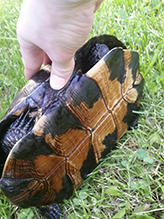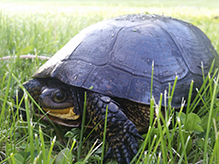Blanding’s Turtle
(Emydoidea blandingii)
Conservation • Description • Habitat • Biology • Distribution • Taxonomy
Conservation Status |
|
|||||||
| IUCN Red List | EN - Endangered |
|||||||
| NatureServe | N4 - Apparently Secure S2 - Imperiled |
|||||||
| Minnesota | Threatened Species in Greatest Conservation Need |
|||||||
Description |
||
Blanding’s Turtle is a long-lived, medium-sized turtle. Adult males are of 6¾″ to 10¾″ in length. Females are a little smaller. The hard upper shell (carapace) is elongated, smooth, and high domed. It is black with scattered yellow flecks or dots. It does not have a longitudinal raised ridge. In some individuals the carapace appears almost entirely black. The scales (scutes) that form the carapace are flat, not sculpted. The lower shell (plastron) is hinged between the forward (pectoral) and rear (abdominal) scutes, allowing it to completely close its shell. There is a V-shaped notch near the tail. Each scute has a large dark blotch on the outer edge, at least at the rear corner. On males the plastron is slightly concave. On females it is more flat. The head, neck, legs, and tail are black or dark brown and are sometimes speckled with yellow. The chin, throat, and underside of the neck are bright yellow. The head is elongated and small. The snout is short and rounded. The upper jaw is notched, giving the appearance of a permanent smile. On females the upper jaw has some yellowish, vertical striping. On males, the upper jaw is black and unmarked. The neck is short. The neck and head together are less than half as long as the plastron. The legs are modified for swimming but are not flipper-like. The toes are webbed. The tail is short, less than half as long as the carapace. The female has a narrower tail than the male. |
||
Size |
||
Carapace length: 6¾″ to 10¾″ |
||
Similar Species |
||
Habitat |
||
Shallow wetlands near sandy uplands. |
||
Biology |
||
Behavior |
||
The hinged plastron allows the turtle to close the front of its shell. The concave plastron on males facilitates mating. It is the first turtle to submerge when disturbed and the last to emerge after being disturbed. |
||
Lifespan |
||
75 years or more |
||
Life Cycle |
||
As the temperature drops in mid-October, Blanding’s Turtles turtles burrow into the muddy bottom of the deepest parts of a marsh, pond, or stream. They enter a state of sluggishness, inactivity, and torpor (brumation). It is similar to hibernation in mammals, but they stir occasionally to drink water or to bask in warm sunshine at ice margins. They emerge the following April and bask in the sun away from the shore. Mating takes place throughout the warm season but mostly in April and May. In late May to early June, after mating, the female finds an open sandy area to nest. She digs a hole about 6¾″ deep and deposits her clutch of eggs. The clutch size about 10 eggs on average but may be from 6 to 21. The eggs are elliptical and about 1½″ long. Hatchlings emerge from early August to mid-October. In mid-October Blanding’s Hatchling mortality is high. Adults can survive 75 or more years. Females reach sexual maturity in 12 or more years. |
||
Food |
||
Crayfish, insects, leeches, snails, small fish, frogs, berries, and other plant material. |
||
Distribution |
||||
|
Sources |
|||
| 9/16/2021 | ||||
Occurrence |
||||
Widespread |
||||
Taxonomy |
|||
| Class | Reptilia (Reptiles) | ||
| Order | Testudines (turtles and tortoises) | ||
| Suborder | Cryptodira (hidden-necked turtles) | ||
| Superfamily | Testudinoidea | ||
Family |
Emydidae (pond and box turtles) | ||
Subfamily |
Emydinae | ||
Genus |
Emydoidea | ||
Two classification schemes for the four turtles formerly included in the genus Clemmys have been proposed. In one scheme Blanding’s Turtle and three other species are included in the genus Emys. In the other scheme Blanding’s Turtle is the only species in the genus Emydoidea. Both names, Emydoidea blandingii and Emys blandingii, are currently (2014) in use. |
|||
Subordinate Taxa |
|||
|
|||
Synonyms |
|||
Cistuda blandingii Cistudo blandingii Emys blandingii Emys twentei Testudo flava Testudo meleagris |
|||
Common Names |
|||
Blanding’s Turtle |
|||
Glossary
Brumation
Winter dormancy in reptiles. A cold-induced period of sluggishness, inactivity, and torpor in reptiles, akin to hibernation in mammals, but they stir occasionally to drink water.
Carapace
The hard, upper (dorsal), shell-like covering (exoskeleton) of the body or at least the thorax of many arthropods and of turtles and tortoises. On crustaceans, it covers the cephalothorax. On spiders, the top of the cephalothorax made from a series of fused sclerites.
Plastron
The hard, lower (ventral), shell-like covering (exoskeleton) of the body of turtles and tortoises.
Scute
A hard, external scale that forms part of the exoskeleton; as on the belly of a snake, the upper and lower shells of hard-shelled turtles, and the foot of a bird.
Visitor Photos |
|||||
Share your photo of this reptile. |
|||||
| This button not working for you? Simply email us at info@MinnesotaSeasons.com. Attach one or more photos and, if you like, a caption. |
|||||
Julie Swenson |
|||||
Blanding turtle located in the cul de sac of Hillcrest Drive in Stacy, MN |
|||||
 |
|||||
Nancy Falkum |
|||||
 |
|||||
Mike Poeppe |
|||||
 |
 |
||||
 |
|||||
Luciearl |
|||||
| Over several years, I have only seen this turtle 3 times. She comes up from my pond to lay her eggs in dry sandy soil. Like clockwork, it happens 6/15-6/17 between 4-7 pm. I have not witnessed little Blandings, but hoped some have survived. Please don't disturb if one is seen laying eggs. |  |
||||
NASCARLYLE |
|||||
 |
|||||
Brian Blom |
|||||
 |
 |
||||
Christa Kluender |
|||||
Found near my home. Left alone in same spot/direction. I think it may have been a male. |
|||||
 |
 |
||||
 |
|||||
Pamela Freeman |
|||||
Found in road near my home. Re-located it in direction it was going.
|
 |
||||
MinnesotaSeasons.com Photos |
|||||
 |
 |
||||
 |
 |
||||

Visitor Videos |
|||
Share your video of this reptile. |
|||
| This button not working for you? Simply email us at info@MinnesotaSeasons.com. Attach a video, a YouTube link, or a cloud storage link. |
|||
Other Videos |
|||
| Blandings Turtle teekay099 |
|||
About
Uploaded on May 26, 2009 Blandings Turtle. Notice the high shell and the yellow chin. Found this critter in central Minnesota in May 2009 |
|||
| The Blanding's Turtle: Ontario Wildlife Video Series Ryan M. Bolton |
|||
About
Published on Dec 4, 2012 Donation Page: http://www.artofconservation.ca/RMBolton/support.htm Educational video of the Blanding's Turtle (Emydoidea blandingii) and its conservation in Ontario, Canada. Filmed, edited, and narrated by Ryan M. Bolton, MSc © Ryan M. Bolton Donated Music: Additional stock footage donated by Paul Whippey (fox pups) and Joe Vass (crayfish). |
|||
| BLANDING'S TURTLE (Emydoidea blandingii) GardenStateTortoise |
|||
About
Published on Aug 17, 2012 Chris Leone of Garden State Tortoise presents: "BLANDING'S TURTLE" A music video montage featuring a look at the life of one of North America's most fascinating species of fresh water turtle. To coincide with the release of REPTILES MAGAZINE'S October 2012 issue which displays a thorough article written by Chris about the Blanding's turtle, this video is a bonus for viewers already familiar with the species as well as an excellent briefing to those just finding out about them. Please spread the word and pass this video along to help educate the public on these beautiful but endangered turtles. The song in the video is Chris Leone's own "Scream Through a Whisper" and can be found on the album "Live Like You Know What You're Leaving" by the band Wicker Hollow |
|||
| Blanding's Turtle (Emydoidea blandingii) WisCBMnetwork |
|||
About
Published on Mar 13, 2013 Blanding's Turtle profile: |
|||
| Cool Science - Blanding's Turtle (Emydoidea blandingii) Science North |
|||
About
Uploaded on Sep 14, 2010 Staff Scientist Bruce Doran talks about one of Ontario's native species-at-risk, the Blanding's turtle, with a little help from some of the animal ambassadors at Science North. Read the entire Cool Science post: http://sciencenorth.ca/coolscience/science-post.aspx?id=402 |
|||


Created: 10/30/2014
Last Updated:










